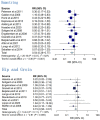Effects of Different Hamstring Eccentric Exercise Programs on Preventing Lower Extremity Injuries: A Systematic Review and Meta-Analysis
- PMID: 36767424
- PMCID: PMC9916392
- DOI: 10.3390/ijerph20032057
Effects of Different Hamstring Eccentric Exercise Programs on Preventing Lower Extremity Injuries: A Systematic Review and Meta-Analysis
Abstract
This systematic review and meta-analysis aims to investigate the effects and differences of various hamstring eccentric training protocols for the prevention of lower limb injuries, and we further propose a more refined hamstring eccentric training protocol for the prevention of lower limb injuries. A literature search for the effects of hamstring eccentric training on lower extremity sports injuries was conducted using the PubMed, Web of Science, and EMBASE databases, and the literature was searched covering the period from the date of the database's creation to 20 August 2022. A meta-analysis of the included literature was performed using R.4.21 for lower extremity injuries, injuries in various parts of the lower extremity, and subgroup analysis for exercise frequency, exercise cycle, and exercise population. A total of 23 randomized controlled trial (RCT) studies were found to be included in the meta-analysis, and 15 of these trials, totaling 14,721 patients, were determined to be included in the overall lower extremity injury prevention effect. The analysis showed that the implementation of a hamstring eccentric training program reduced lower extremity injuries by 28%, and it resulted in a 46% decrease in hamstring injury rate and a 34% decrease in knee injury rate. The subgroup analysis revealed that the frequency of exercise was most significant in the twice-a-week exercise group, that the exercise program was most effective in preventing injuries in the 21-30-week exercise period, and that the program was most effective in preventing injuries in elite athletes and amateur adult athletic populations, compared with adolescents.
Keywords: eccentric training; hamstring; injuries; prevention; training program.
Conflict of interest statement
The authors declare no conflict of interest.
Figures






Similar articles
-
Effect of Injury Prevention Programs that Include the Nordic Hamstring Exercise on Hamstring Injury Rates in Soccer Players: A Systematic Review and Meta-Analysis.Sports Med. 2017 May;47(5):907-916. doi: 10.1007/s40279-016-0638-2. Sports Med. 2017. PMID: 27752982
-
A systematic review and network meta-analysis on the effectiveness of exercise-based interventions for reducing the injury incidence in youth team-sport players. Part 2: an analysis by movement patterns.Ann Med. 2024 Dec;56(1):2337724. doi: 10.1080/07853890.2024.2337724. Epub 2024 Apr 13. Ann Med. 2024. PMID: 38614120 Free PMC article.
-
Eccentric training for prevention of hamstring injuries may depend on intervention compliance: a systematic review and meta-analysis.Br J Sports Med. 2015 Mar;49(6):349-56. doi: 10.1136/bjsports-2014-093466. Epub 2014 Sep 16. Br J Sports Med. 2015. PMID: 25227125
-
A systematic review and network meta-analysis on the effectiveness of exercise-based interventions for reducing the injury incidence in youth team-sport players. Part 1: an analysis by classical training components.Ann Med. 2024 Dec;56(1):2408457. doi: 10.1080/07853890.2024.2408457. Epub 2024 Oct 1. Ann Med. 2024. PMID: 39351708 Free PMC article.
-
Exercise for intermittent claudication.Cochrane Database Syst Rev. 2017 Dec 26;12(12):CD000990. doi: 10.1002/14651858.CD000990.pub4. Cochrane Database Syst Rev. 2017. PMID: 29278423 Free PMC article.
Cited by
-
The effects of training intervention on the prevention of knee joint injuries: a systematic review and meta-analysis.Front Physiol. 2025 Feb 24;16:1455055. doi: 10.3389/fphys.2025.1455055. eCollection 2025. Front Physiol. 2025. PMID: 40066285 Free PMC article.
-
The Effects of Reverse Nordic Exercise Training on Measures of Physical Fitness in Youth Karate Athletes.J Funct Morphol Kinesiol. 2024 Dec 10;9(4):265. doi: 10.3390/jfmk9040265. J Funct Morphol Kinesiol. 2024. PMID: 39728249 Free PMC article.
-
What is the Injury Incidence and Profile in Professional Male Ice Hockey? A Systematic Review.Int J Sports Phys Ther. 2024 Jan 2;19(1):1398-1409. doi: 10.26603/001c.90591. eCollection 2024. Int J Sports Phys Ther. 2024. PMID: 38179586 Free PMC article.
-
Normative isokinetic knee strength values and prediction models in non-athletic Chinese adults.Front Bioeng Biotechnol. 2025 May 21;13:1573267. doi: 10.3389/fbioe.2025.1573267. eCollection 2025. Front Bioeng Biotechnol. 2025. PMID: 40470506 Free PMC article.
-
Weekly Programming of Hamstring-Related Training Contents in European Professional Soccer.Sports (Basel). 2024 Mar 5;12(3):73. doi: 10.3390/sports12030073. Sports (Basel). 2024. PMID: 38535736 Free PMC article.
References
-
- Engebretsen A.H., Myklebust G., Holme I., Engebretsen L., Bahr R. Prevention of injuries among male soccer players: A prospective, randomized intervention study targeting players with previous injuries or reduced function. Am. J. Sports Med. 2008;36:1052–1060. doi: 10.1177/0363546508314432. - DOI - PubMed
Publication types
MeSH terms
LinkOut - more resources
Full Text Sources
Medical

